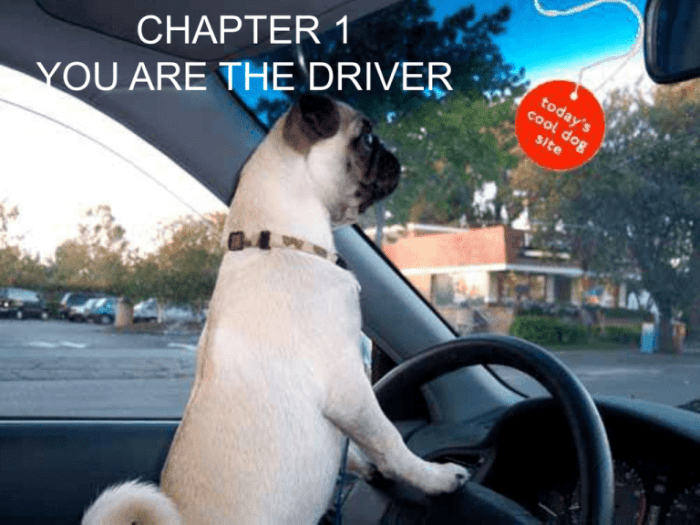Chapter 1 you are the driver – In chapter 1, “You Are the Driver,” we embark on an empowering journey of self-discovery and transformation. This chapter emphasizes the significance of personal responsibility and decision-making, urging us to take ownership of our lives and drive our destiny.
As we delve into the intricacies of personal growth and development, we’ll explore the challenges and obstacles that may arise, as well as strategies for overcoming them. Through inspiring stories, practical advice, and a framework for effective decision-making, we’ll empower you to take control of your life and steer it towards your desired destination.
Introduction

The phrase “You are the driver” holds immense significance in the context of personal responsibility and decision-making. It underscores the idea that individuals are ultimately accountable for their choices and the consequences that follow.
Throughout our lives, we are constantly faced with situations that require us to make decisions. These decisions can range from seemingly trivial matters to life-altering choices. The choices we make shape our lives and determine our destiny.
Personal Responsibility
The concept of personal responsibility emphasizes that individuals are answerable for their actions and the outcomes that stem from them. It implies that we cannot blame others or external factors for our choices and must take ownership of our decisions.
- For instance, if we choose to indulge in unhealthy habits, we cannot hold others accountable for any health problems that arise as a consequence.
- Similarly, if we make poor financial decisions, we must accept responsibility for the financial consequences rather than blaming circumstances.
Decision-Making
Effective decision-making involves carefully considering the available options, weighing the potential outcomes, and making informed choices. It requires critical thinking, self-awareness, and a clear understanding of our values and goals.
- When faced with a difficult decision, it is crucial to gather information, seek advice from trusted sources, and introspect on our motivations.
- By taking a proactive approach to decision-making, we increase the likelihood of making choices that align with our best interests and lead to positive outcomes.
Responsibility and Ownership

Taking ownership of one’s actions and decisions is crucial for personal growth and success. It empowers individuals to control their destiny, learn from mistakes, and build resilience.
Blaming others or external factors for negative outcomes is counterproductive. It prevents individuals from acknowledging their own role in the situation and hinders their ability to improve. By taking responsibility, individuals can identify areas for growth and take steps to rectify the situation.
Developing Personal Accountability
- Self-Reflection:Regularly assess one’s actions and decisions to identify areas for improvement.
- Avoid Excuses:Accept responsibility for mistakes and learn from them instead of blaming others.
- Set Realistic Goals:Establish achievable goals to avoid feeling overwhelmed and discouraged.
- Seek Feedback:Actively ask for constructive criticism from trusted individuals to gain a different perspective.
- Reward Successes:Acknowledge and celebrate accomplishments to reinforce positive behavior.
Self-Empowerment
Embracing the role of “driver” is a catalyst for self-empowerment, igniting a sense of ownership and control over one’s life. It entails recognizing our agency and taking proactive steps to shape our destiny, fostering a mindset of responsibility and accountability.
The psychological benefits of self-driven initiatives are profound. By taking control, we cultivate a sense of purpose and direction, reducing feelings of helplessness and victimhood. It boosts our self-esteem, as we witness the tangible outcomes of our efforts, and encourages resilience in the face of challenges.
Transformative Examples
Numerous individuals have exemplified the transformative power of self-empowerment. Oprah Winfrey, once an impoverished child, rose to become a media mogul and philanthropist through sheer determination and hard work. Similarly, Malala Yousafzai, the Nobel Peace Prize laureate, defied societal norms to advocate for girls’ education, empowering herself and countless others.
Decision-Making: Chapter 1 You Are The Driver
Effective decision-making is crucial for achieving personal and professional goals. A well-structured approach can guide you towards informed choices that align with your values and aspirations.
Framework for Decision-Making, Chapter 1 you are the driver
1.
-
-*Identify the Decision
Clearly define the problem or opportunity you face.
- 2.
- 3.
- 4.
- 5.
- 6.
- 7.
-*Gather Information
Collect relevant data, consult experts, and consider different perspectives.
-*Consider Values and Goals
Evaluate how the decision aligns with your core values and long-term goals.
In Chapter 1, “You Are the Driver,” you’ll navigate the complexities of Southwest Asia. To enhance your understanding, take a break and try our map of Southwest Asia quiz . It’s a fun and informative way to test your knowledge and prepare for the challenges that lie ahead in the driver’s seat.
-*Generate Options
Brainstorm potential solutions and explore alternatives.
-*Evaluate Options
Weigh the pros and cons of each option, considering both objective and subjective factors.
-*Make a Choice
Select the option that best meets your needs and goals.
-*Take Action
Implement the decision and monitor its outcomes.
Role of Intuition, Logic, and External Advice
Effective decision-making involves a balance of intuition, logic, and external advice.*
-*Intuition
Your gut feeling or subconscious knowledge can provide valuable insights.
-
-*Logic
Rational analysis and objective reasoning help you make informed choices based on evidence.
-*External Advice
Seek input from trusted friends, mentors, or experts to gain different perspectives.
Decision-Making Styles
Different individuals have distinct decision-making styles. Understanding these styles can help you identify your strengths and areas for improvement.| Decision-Making Style | Pros | Cons ||—|—|—|| Rational | Logical, objective, data-driven | Can be slow and inflexible || Intuitive | Fast, creative, holistic | Can be subjective and impulsive || Collaborative | Involves input from others, consensus-based | Can be time-consuming and prone to groupthink || Dependent | Relies heavily on external advice, seeks approval | Can lead to indecisiveness and lack of ownership || Avoidant | Postpones or delegates decision-making, seeks comfort in the status quo | Can lead to missed opportunities and poor outcomes |
Challenges and Obstacles

Embarking on the journey of self-ownership inevitably entails encountering challenges and obstacles. These roadblocks can stem from within ourselves, such as self-limiting beliefs and negative thought patterns, or from external sources, such as societal expectations or limited resources. Acknowledging and addressing these hurdles is crucial for progress and personal growth.
One significant obstacle is the grip of self-limiting beliefs. These are deeply ingrained thoughts and assumptions about ourselves that hold us back from reaching our full potential. They often manifest as negative self-talk, such as “I’m not good enough” or “I can’t do this.”
Overcoming these beliefs requires challenging them with evidence, reframing them in a more positive light, and practicing self-compassion.
Strategies for Overcoming Obstacles
- Identify and Challenge Negative Beliefs:Recognize the self-limiting thoughts that hinder you and question their validity. Seek evidence to refute them and replace them with more empowering beliefs.
- Practice Self-Compassion:Treat yourself with the same kindness and understanding you would offer a friend. Forgive your mistakes, learn from them, and focus on your strengths.
- Seek Support:Surround yourself with positive and supportive people who believe in your abilities. Share your challenges and seek their encouragement and advice.
- Set Realistic Goals:Break down large goals into smaller, achievable steps. This will make the journey seem less daunting and increase your motivation.
Examples of Overcoming Adversity
History is replete with examples of individuals who have triumphed over adversity to achieve their dreams. From Stephen Hawking, who defied the limitations of ALS to become a renowned physicist, to Malala Yousafzai, who stood up for the education of girls despite threats to her life, these stories serve as a testament to the human spirit’s resilience and determination.
Growth and Development

Taking the role of “driver” in life can lead to significant personal growth and development. By embracing responsibility and ownership, individuals embark on a journey of self-discovery and transformation.Setting clear goals provides direction and motivation, while taking calculated risks pushes boundaries and expands capabilities.
Each experience, both successful and challenging, becomes a valuable lesson, shaping perspectives and fostering resilience.
Stories of Transformation
Countless individuals have shared their inspiring journeys of self-empowerment and growth. One such example is Malala Yousafzai, who defied adversity to become a global advocate for education. Her unwavering determination and refusal to be silenced empowered her to make a profound impact on the world.
Inspiration and Motivation

Taking ownership of our lives is a journey that requires both inspiration and motivation. These elements fuel our desire to drive our lives forward and embrace the challenges that come with it.
Inspiring stories and quotes can ignite a spark within us, reminding us of the potential we hold. By surrounding ourselves with positive influences and affirmations, we cultivate a mindset that empowers us to take charge of our lives.
Inspiring Quotes and Stories
- “The only person you are destined to become is the person you decide to be.” – Ralph Waldo Emerson
- “The future belongs to those who believe in the beauty of their dreams.” – Eleanor Roosevelt
- “You don’t have to be great to start, but you have to start to be great.” – Zig Ziglar
Affirmations and Mantras
Affirmations are positive statements that we repeat to ourselves to reinforce our beliefs and cultivate a growth mindset.
- I am capable of achieving my goals.
- I am worthy of success.
- I am resilient and can overcome challenges.
Characteristics of Drivers vs. Passengers
Individuals who take ownership of their lives possess distinct characteristics that set them apart from those who passively accept their circumstances.
| Drivers | Passengers |
|---|---|
| Proactive | Reactive |
| Accountable | Blame others |
| Growth-oriented | Fixed mindset |
| Solution-focused | Problem-focused |
| Empowered | Disempowered |
Essential FAQs
What does it mean to be the “driver” of my life?
Being the “driver” means taking ownership of your actions, decisions, and life’s direction. It involves recognizing your power to shape your destiny and making choices that align with your values and goals.
How can I overcome self-limiting beliefs?
Overcoming self-limiting beliefs requires challenging negative thought patterns, practicing positive self-talk, and surrounding yourself with supportive people. Remember, your beliefs are not facts, and you have the power to change them.
What is the best way to make informed decisions?
Informed decision-making involves considering your values, goals, and available information. Weigh the pros and cons of different options, seek advice from trusted sources, and trust your intuition.